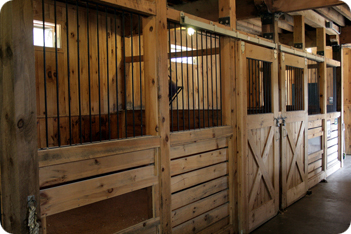
Horse Stable Types
From: Horse Stables And Barns

Types Of Horse Stable
There are two main types of stables, traditional stabling and barn stabling.
Traditional Stables
This is where there is either a single stable or several stables next to each other, each one with a stable door that opens out directly onto an open yard.
Advantages
- Each stable should have a window to allow for adequate ventilation.
- Each stable should have adequate roof ventilation.
A roof overhang over the stable door offers the horses protection against the rain and in the summer can offer some shade. - By having each horse housed in there own stable decreases the risk of cross infection.
The horses can often see other horses on the yard. - Each stable has its own individual access.
- Traditional stables can be used for any number of horses with the benefit that you can always add more stables on if you need them and have the space.
- Isolation boxes can be individually disinfected, without having to do the whole yard.
- Stables can in many cases also be easily converted into tack, feed and rug drying rooms.
- You can see to one horse in the night without having to wake up the entire yard.
- If a horse needs to be on shavings or rubber matting due to a dust allergy there needs can be easily monitored within a private box.
Disadvantages
- Each horses personal equipment must be stored in a tack or rug room as it cannot be left outside the horses box.
- Some horses prefer to be able to see other horses when inside the stable, the addition of side window panels that can be left either open or closed can be solution in this case.
Barn Stabling
This is where several horses are all housed under one roof in individual units.
Advantages
- American barn stabling often has grilles in between each stable unit to allow all the horses to see each other.
- Each stable leads out onto a central walkway in between the stables that then leads to the outside.
- The whole stabling section is undercover.
- All the horses can see each other and what is going on.
- Many stables have windows to the rear of the stable allowing the horse access to fresh air.
- High roofs allow for adequate ventilation but air flow should always be monitored.
- Large numbers of horses can be housed all under one roof.
- The horses rugs, grooming and any other kit can be stored outside the stable.
- If the central walkway is wide enough then delivery of shavings, hay and straw can be easily dropped off by a small vehicle
Disadvantages
- Some horses find the busy atmosphere stressful.
- It can be difficult to deal with one horse late at night without disturbing all the others.
- Infection can spread rapidly throughout an indoor barn situation.
- Tying up facilities can be limited outside the stable.
- Horses with allergies to hay or straw can be more difficult to manage unless horses in several of the surrounding boxes are also on allergy friendly feed and bedding.